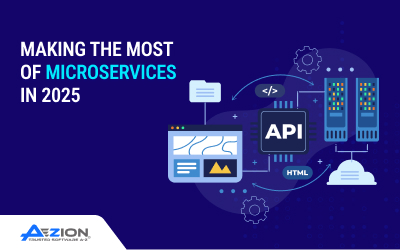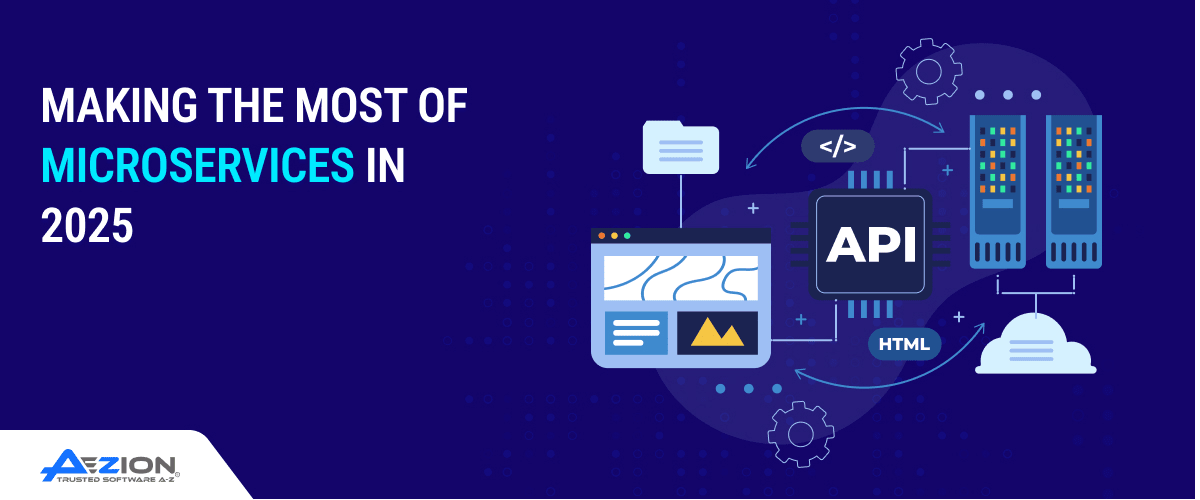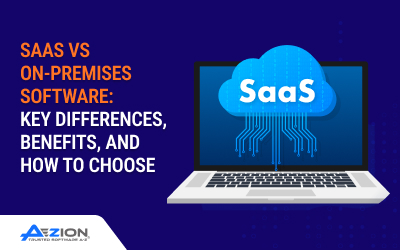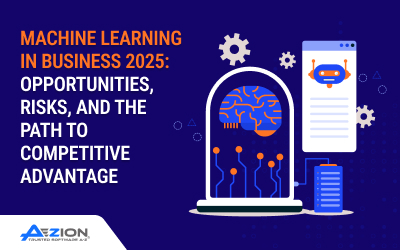Introduction: Why Microservices Remain Relevant
Agility and flexibility are inevitable in the current high-speed, digital-native commercial environment. With companies competing to provide faster and more reliable software experiences, microservices architecture has become fundamental to digital engineering.
Microservices represent a strategic enabler for organizations looking to automate the speed of development and deployment, take advantage of technology elasticity at scale, and achieve a high level of interdependence between digital applications. With cloud-native development on the rise, AI integration, and distributed systems, microservices have grown into a mature pattern for every organization, from startup platforms to Fortune 500 ecosystems. IDC forecasts that by 2025, over 90% of new enterprise apps will be built as cloud‑native systems based on microservices
For this reason, microservices are still at the forefront of our design solutions, enabling customers to speed up product delivery, enhance reliability, and tap into long-term business value.
In this blog, we will understand more about microservices.
What Are Microservices?
Microservices are a newer architectural style in which software systems consist of small, autonomous services communicating through lightweight APIs. Each service is centered on business capability and can be developed, deployed, and scaled individually, allowing high resiliency and agility.
As cloud-native development becomes the norm in 2025, microservices are the new default model for scalable, modular application design. In contrast to the traditional monolithic architecture, where all features are packaged into one, tightly coupled codebase, microservices enable teams to partition applications into fine-grained, loosely coupled services. This separation fuels speed, efficiency, and innovation.
This change is revolutionizing software delivery on scale.
Microservices vs. SOA and Modular Monoliths
| Architecture | Key Traits | Best Use Cases |
| Monolith | Single codebase, tightly coupled | Simpler applications, early-stage startups |
| SOA | Shared services, enterprise bus, heavy protocols | Legacy enterprise systems |
| Microservices | Independently deployable services, API-based | Cloud-native, scalable, DevOps-enabled systems |
| Modular Monolith | Structured modules inside a monolith | Mid-sized apps where full microservices may be overkill |
Business Benefits of Microservices
Microservices address technical problems and produce tangible business value by coordinating technology choices with strategic results. In digital engineering, microservices enable organizations to get faster, respond more quickly, and be more agile in changing business needs. Let’s have a look at how it is beneficial to businesses.
1. Faster Time-to-Market
Microservices allow companies to develop, test, and deploy features in isolation. This modularity shortens release cycles and enables enterprises to react rapidly to customer demands and market opportunities without waiting for a monolithic codebase to settle.
2. More Agility and Innovation
Each service belongs to a special group, and the developers are free to experiment, innovate, and iterate with few dependencies. This independence fosters a culture of incremental improvement — a prime motivator in digital engineering strategies.
3. Effortless Scalability
Services can be scaled independently without affecting the usage. For instance, if the payment gateway or search functionality observes excessive traffic, only microservice can be scaled, conserving cloud resources and enhancing performance.
4. Improved Fault Isolation and System Resilience
When a single microservice fails, the application does not go down. This isolation reduces downtime, improves availability, and builds a better-quality user experience, essential for business continuity.
5. Better Use of Tech Stacks
Various services may be developed utilizing the best programming language or database. Such flexibility enhances innovation and performance tuning at a detailed level.
Technical Advantages of Microservices Architecture
Technically speaking, microservices offer flexibility and scalability that conventional structures cannot match. They are designed specifically for today’s cloud-native, DevOps-based, and API-centric software environments — all of which are the cornerstones of contemporary digital engineering solutions.
1. Cloud-Native and Container Integration
Microservices flourish in worlds fueled by containers (Docker) and container orchestration environments (Kubernetes). Every microservice can be run as a container, allowing standardized environments throughout dev, staging, and production.
This architecture aligns organically with cloud-platform scalability and elasticity — public, private, or hybrid — so engineering teams can dynamically scale workloads according to traffic and demand.
2. Increased Developer Productivity and CI/CD Support
Microservices allow teams to leverage continuous integration and continuous delivery (CI/CD) pipelines, which automate builds, tests, and releases. Services can be updated and rolled back independently since they are decoupled, reducing risk and speeding up innovation.
It also prefers smaller, specialized codebases, which are easier to maintain, test, and debug, ultimately making delivery faster and reducing technical debt.
3. Serverless and Edge Computing Models
Microservices are well-suited to work with serverless computing (AWS Lambda, Azure Functions), where code runs in response to events. They also work fine in edge architecture, moving a computer near the user to reduce latency and improve real-time responsiveness.
This positions microservices as ideal for handling high-performance, distributed applications such as IoT platforms, e-commerce engines, and AI-powered APIs.
4. Improved Observability and Monitoring
Microservices need robust observability practices; today’s tooling supports it more easily. With OpenTelemetry, Prometheus, and Jaeger technologies, teams can observe service health, trace requests through distributed systems, and record anomalies in real-time.
Challenges and Considerations
While microservices have numerous advantages, they introduce architectural complexity and operational challenges that must be handled strategically. Let’s have a look at some of them.
1. Distributed Systems Complexity
One of the largest trade-offs for microservices is operational complexity on a larger scale. You’re no longer dealing with one application; now you’re dealing with a network of services with their deployment, scaling rules, logs, and monitoring.
You need complex coordination in this distributed system, particularly when services are interdependent and must talk frequently.
2. Data Consistency and Integrity
In monoliths, data consistency is usually made sure through one database. In microservices, each service should have its own data store, leading to the requirements of eventual consistency, synchronization of data, and distributed transactions. For all of these, proper planning is required, which can be done by digital engineering service experts.
Data accuracy across services without compromising performance is one of the most significant technical challenges.
3. Larger Security Surface Area
Each microservice presents an API, which increases the attack surface. Securing authentication, authorization, encryption, and API security across tens (or even hundreds) of services demands sophisticated identity management and zero-trust security models.
Digital engineers must embed security in each development and deployment cycle phase.
4. Tooling and DevOps Maturity
Microservices flourish where there are mature DevOps pipelines, automated testing, good monitoring, and controlled release. Most other organizations end up with broken deployments, version conflicts, or missing services.
Moving to microservices is as much an organizational and cultural transition as a technical one.
5. Managing Service Dependencies
As microservices mature, so do their dependencies. Without good design patterns (such as service registries, circuit breakers, and backpressure mechanisms), an innocent-looking failure in a single service can cascade and result in significant disruptions.
Microservices vs. Alternatives: When to Choose What
While microservices are powerful, they’re not a one-size-fits-all solution. The complexity of your system should guide the decision to adopt microservices, the scale of operations, and your team’s readiness. Sometimes, a modular monolith or serverless architecture might be a better fit.
Below is a comparative breakdown to help evaluate architectural choices in a modern digital engineering context:
| Architecture | Best For | Pros | Trade-offs |
| Monolith | Small, simple applications | Easier to build and deploy | Becomes rigid and complex as the codebase grows |
| Modular Monolith | Mid-sized systems with a need for structure | Organized codebase, low operational overhead | Still deployed as a single unit |
| Microservices | Large, scalable, fast-changing apps | Independent scaling, agile teams, and resilience | High complexity requires DevOps maturity |
| Serverless | Event-driven apps, real-time processing | Cost-efficient, no infra management | Cold start latency, vendor lock-in |
When Microservices Make Sense
- Building a large system that requires scalability and rapid iteration
- Mature DevOps and CI/CD pipelines in place
- Digital engineers are autonomous and aligned with domain-driven design
- High system availability and fault isolation
When to Consider Alternatives
- System in the MVP or early growth stage
- Product logic is still evolving and doesn’t need distributed complexity
- Lack of team structure or tools to manage microservices
Modern Microservices Design Principles
Effective microservices demand design principles ensuring scalability, resilience, and long-term maintainability. In 2025, engineering teams are adopting patterns based on domain knowledge, system observability, and infrastructure abstraction.
The following are some of the most important design principles motivating enterprise-ready microservices:
1. Domain-Driven Design (DDD)
Domain-driven design is at the core of microservices, which encourages designing services based on business capabilities. Rather than creating systems according to technical layers like UI, logic, and database. DDD designs them according to bounded contexts — i.e., each microservice is an independent, specific domain (billing, user management, inventory).
This alignment minimizes coupling, improves clarity, and makes every service more scalable and maintainable independently.
2. Event-Driven Architecture (EDA)
To reduce direct dependencies, microservices communicate using asynchronous events rather than synchronous calls. In an event-driven architecture:
- Services emit events
- Other services subscribe and respond accordingly
This style provides better scalability and decoupling, especially in real-time applications such as logistics, financial platforms, and IoT solutions.
3. API Gateway & Service Mesh
Having dozens of APIs can become complex. API Gateway provides a single entry point for every microservice to manage:
- Authentication and authorization
- Requests
- Rate limiting and catching
4. Resilience and Circuit Breakers
Modern systems use resilience patterns to handle service failures gracefully. For example:
- Circuit breakers stop repeated calls to failing services
- Retries and timeouts are set to prevent bottlenecks
- Bulkheads isolate failures in one service from spreading to others
These patterns protect overall system health and improve user experience even during partial failures.
5. Observability Built-In
Logging, tracing, and monitoring need to be baked in initially. With tools like OpenTelemetry, Jaeger, and Grafana, teams can visualize and trace distributed requests. This is essential for debugging and performance tuning in a microservices architecture.
Tooling & Technologies Powering Microservices
Microservices need more than architectural design. They need a mature toolchain ecosystem, platforms, and practices to enable development, deployment, observability, and scalability. As of 2025, microservices technology has become cloud-native, streamlined, and automation-oriented.
The following is a curated stack that allows end-to-end microservices development in contemporary digital engineering teams:
1. Containerization & Orchestration
- Docker: Common container runtime to bundle services with their dependencies.
- Kubernetes (K8s): Most popular orchestration platform for container deployment, scaling, and networking.
2. CI/CD and DevOps
- GitHub Actions / GitLab CI / Jenkins X: Automate build, test, and deploy pipelines.
- ArgoCD / Flux: Support GitOps-based deployment strategies for declarative infrastructure management.
3. API Management & Communication
- Kong / Apigee / AWS API Gateway: Unify API control, security, and traffic policies.
- gRPC / REST / GraphQL: Internal and external service communication with latency and payload requirements.
- Apache Kafka / RabbitMQ: Event-driven communication software that provides asynchronous message streaming between services.
4. Monitoring, Logging, and Tracing
- Prometheus & Grafana: Real-time metrics collection and visualization.
- OpenTelemetry: One standard for distributed tracing, logs, and metrics.
- ELK Stack (Elasticsearch, Logstash, Kibana): Centralized log collection and analysis.
5. Security and Governance
- OAuth 2.0 / OpenID Connect: Secure, standardized identity/authentication protocols.
- HashiCorp Vault / AWS Secrets Manager: Secure secrets and environment variables across microservices.
- Service Mesh (Istio, Linkerd): Manages service-to-service encryption, access control, and observability at the network level.
6. Deployment Environments
- AWS ECS/EKS, Azure AKS, Google GKE: Fully managed Kubernetes services that speed up enterprise adoption.
- Serverless Extensions: Many organizations complement microservices with AWS Lambda or Azure Functions for small-footprint event-based components.
Real-World Use Cases
Microservices are driving the most scalable, forward-thinking digital platforms. Here are real-world use cases of companies across industries using microservices to gain agility, scalability, and resilience.
1. Netflix: Microservices for Global Entertainment
Netflix was among the first companies to adopt microservices, utilizing the architecture to shift from a DVD rental business to a worldwide streaming giant. Its infrastructure now hosts more than 700 microservices, each responsible for operations such as user personalization, billing, or recommendations.
With this architecture, Netflix can:
- Deploy thousands of code changes daily without impacting user experience
- Scale single services according to user location or viewing behavior
- Experiment with new features quickly via canary releases
2. Amazon: Microservices for Modular Retail Operations
Amazon popularly broke up its monolithic app into microservices so teams could develop, test, and release features in isolation. From product search to payments to delivery tracking, every operation is run by its service.
This pattern has allowed Amazon to:
- Keep high uptime through seasonal spikes like Black Friday
- Support hundreds of teams to innovate in parallel
- Support localized experiences for global markets.
Aezion’s Best Practices for a Successful Microservices Strategy
To succeed with microservices on a scale, Aezion’s digital engineering service providers implement the correct strategies. Some of which are –
- Begin with Business Capabilities: Map services back to real-world domains through domain-driven design (DDD).
- Automate Everything: Implement infrastructure-as-code and CI/CD pipelines for quicker, safer deployment.
- Invest in Observability: Leverage centralized logging, monitoring, and tracing to identify problems in distributed systems.
- Secure by Design: Implement zero-trust architecture, encrypt service communication, and secure secrets management.
- Standardize APIs and Contracts: Utilize OpenAPI, version control, and well-defined interface definitions to prevent integration problems.
- Enable cross-functional teams: Give small, self-managing teams ownership of end-to-end services from development to production.
Final Thoughts
Microservices are a building block for scalable digital products in an age that needs speed, durability, and ongoing innovation. If you aim to modernize a legacy application or build for the future, microservices present a well-established route to agility and expansion. Success is not guaranteed, however. It depends on the right strategy, tools, and partner.
We at Aezion have extensive experience architecting, building, and operating microservices for enterprise-class systems. From designing APIs and deploying cloud-native to governance and observability, our engineers enable companies to drive their digital engineering efforts with certainty.
Frequently Asked Questions (FAQs)
How are microservices different from monoliths?
Microservices divide applications into more manageable, separate services that can be developed, deployed, and scaled independently. Monolithic structures contain all functionality within one codebase, which makes them more challenging to scale and modify.
Are microservices appropriate for all kinds of projects?
No. Microservices are best suited for complicated, large-scale systems with several development teams. A modular monolith will be easier and less expensive in small or MVP-phase applications.
What are the biggest challenges with microservices?
Common challenges include managing distributed data, increased system complexity, securing service communication, and building mature DevOps pipelines for automation.
What tools are commonly used in a microservices stack?
Popular tools include Docker, Kubernetes, Kafka, Prometheus, OpenTelemetry, and API gateways like Kong or Apigee. CI/CD pipelines and observability tools are also essential.




